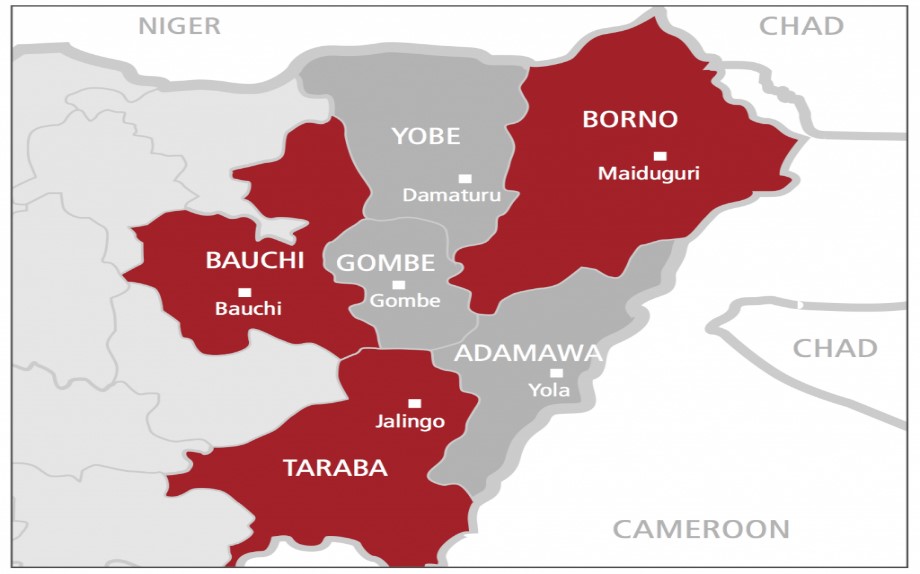Alleviating the Material and Health Challenges of Young Internally Displaced People in North-East Nigeria
The Impact of Sexual and Reproductive Health Program
Abstract
The increasing rate of attack in the North-Eastern parts of Nigeria has caused the deaths of thousands and thereby forcing many of the residents, including children to abandon their comforts zones. This study assessed the material and health challenges of young IDPs and the impacts of sexual and reproductive health programs in improving the conditions of these young ones. The study was conducted in sixteen local governments of three states (Borno, Adamawa and Yobe) in the North-East of Nigeria using mixed methods. The quantitative data were obtained by the administration of a structured questionnaire to the young IDPs in the three states. The quantitative data were analysed and were complemented by the qualitative data {Focus Group Discussions (FGDs)} that were obtained from the young IDPs. Data were analysed using SPSS version 20. The majority (78.5%) of the young internally displace persons (IDPs) were within the age group of 10-14 years with 51.8% males and 59.1% have attained primary. The major material challenges facing the young IDPs include lack of food (31.6%), clothing (28.7%), Soap/cream (19.8%) and medicine (13.1%). The most common health problems include Malaria (28.9%), cough 23.1%, diarrhoea (18.3%) and cholera (13.1%). The IDPs confirmed that they were fully protected in the camp with no experience of rape. They affirmed that their needs were met by the intervention programs provided for them; 71.7% affirmed that their situation was “Good” since they came to the camps and more than half (55.2%) confirmed a better situation. The training in the IPD camps was mostly artisan related while only 31.7% were schooling. This study found that young IDPs are being faced with material and health-related challenges as well as the lack of proper training and education. However, the outcome of the SRH project is a manifestation of the efficient utilization of the resources of the project. More intervention programs to alleviate the challenges of IDPs are advocated.
References
Borton, J., Buchanan-Smith, M., & Otto, R. (2005). Support to Internally Displaced Persons - Learning from Evaluations: Synthesis Report of a Joint Evaluation Programme. Channel Research Ltd. Retrieved from http://www2.sida.se/shared/jsp/download.jsp?f=SIDA4587en_Learning.pdf&a=3435
Cohen, R. (2001). New Challenges for Refugee Policy: Internally Displaced Persons. In Brookings. Retrieved from https://www.brookings.edu/on-the-record/new-challenges-for-refugee-policy-internally-displaced-persons/
DTM NIGERIA. (2019). Baseline Assessment of Displacement. In International Organization for Migration (Issue August).
Elfaituri, S. S. (2016). Skin diseases among internally displaced Tawerghans living in camps in Benghazi, Libya. International Journal of Dermatology, 55(9), 1000-1004. https://doi.org/10.1111/ijd.13115
Eweka, O., & Olusegun, T. O. (2016). Management of Internally Displaced Persons in Africa: Comparing Nigeria and Cameroon. African Research Review, 10(1), 193. https://doi.org/10.4314/afrrev.v10i1.15
Gwadabe, N. M., Salleh, M. A., Ahmad, A. A., & Jamil, S. (2018). Forced Displacement and the Plight of Internally Displaced Persons in Northeast Nigeria. Humanities and Social Science Research, 1(1), p46. https://doi.org/10.30560/hssr.v1n1p46
Hamzat, A. O. (2013). Challenges of the internally displaced persons and the role of society. Retrieved from https://www.thenigerianvoice.com/news/113484/challenges-of-the-internally-displaced-persons-and-the-role.html
Hines, D., & Balletto, R. (2002). Assessment of Needs of Internally Displaced Persons in Colombia. December, 36. Retrieved from https://www.odi.org/sites/odi.org.uk/files/odi-assets/publications-opinion-files/2676.pdf
Mohammed, F. K. (2017). The Causes and Consequences of Internal Displacement in Nigeria and Related Governance Challenges. Working Paper, April 2017, 1-39. Retrieved from http://www.swp-berlin.org%0Aswp@swp-berlin.org
Obaji, S., & Alobo, E. (2016). Internal Displacement in Nigeria and the Case for Human Rights Protection of Displaced Persons. Journal of Law, Policy and Globalization, 51(0), 26-33. Retrieved from http://www.iiste.org/Journals/index.php/JLPG/article/view/32031
Olanrewaju, F. O., Olanrewaju, A., Omotoso, F., Alabi, J. O., Amoo, E., Loromeke, E., & Ajayi, L. A. (2019). Insurgency and the Invisible Displaced Population in Nigeria: A Situational Analysis. SAGE Open, 9(2). https://doi.org/10.1177/2158244019846207
Olanrewaju, F. O., Omotoso, F., & Alabi, J. O. (2018). Datasets on the challenges of forced displacement and coping strategies among displaced women in selected Internally Displaced Persons׳ (IDPs) camps in Nigeria. Data in Brief, 20, 152-158. https://doi.org/10.1016/j.dib.2018.07.042
OPARA, E., & N. (2019). Enhancing protection of internally displaced persons through domestic law and policy. Nnamdi Azikiwe University Journal of International Law and Jurisprudence, 10(2), 77-84.
Prince, C. E., Uzoma, C. O., & Ejimkaraonye, C. (2019). Understanding the Challenges of Northern Forced Migrants: From Escape To Life in Internally Displaced Persons Camps, Abuja. May.
Release, P., Cluster, P., Group, W., Recovery, E., & Working, C. (2008). Protection of Conflict-induced IDPs: Assessment for Action.
UNPFA. (2016). Ngala IDP Camp Quick Assessment Quick Assessment: Ngala IDP Camp Security and logistics. United Nations Population Fund, 1-9. Retrieved from https://data2.unhcr.org/en/documents/download/53084
USAID. (2016). Strengthening Integrated Delivery of HIV/AIDS Services in IDP camps in Borno State. Libraries as Places: Buildings for the 21st Century, May. https://doi.org/10.1515/9783110935622.3
WHO. (2018). Malaria campaign saving young lives in Nigeria. Retrieved from http://www.who.int/malaria/news/2017/emergency-borno-state/en/


This work is licensed under a Creative Commons Attribution 4.0 International License.
Copyright for this article is retained by the author(s), with first publication rights granted to the journal.
This is an open-access article distributed under the terms and conditions of the Creative Commons Attribution license (http://creativecommons.org/licenses/by/4.0/).









1.png)














